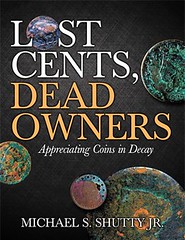
PREV ARTICLE
NEXT ARTICLE
FULL ISSUE
PREV FULL ISSUE
NEW BOOK: LOST CENTS, DEAD OWNERS
Author Mike Shutty forwarded this announcement of his new book on the unusual but interesting topic of coin corrosion - how it occurs
over time, and how to understand and appreciate it. -Editor
This is a book that I always wanted to read. But no one dared to write it. After a long wait, I decided to do it. I think folks will enjoy this one, as it is a celebration of coin collecting for the armchair historian. This book will appeal to anyone who has marveled at a crusty old coin found in the dirt or behind the hutch. From the start, the title – Lost Cents, Dead Owners – lets you know that this is a no-nonsense book. It presents a familiar viewpoint with a twist: “A (lost) coin is history in your hand.” Such musings have unfortunately become lost in a coin marketplace that is obsessed with high-grade, high-value coins. This book opens with the argument that corroded coins are fascinating relics that deserve to be collected. Early on I challenge the reader to appreciate the beauty of verdigris and other colorful products that signal when a coin is returning to nature. Like all great art, I suggest that the evocative impact of corrosion finds its energy in the darker emotions associated with loss, decay, and death. This aesthetic is not new, as classical writers have remarked on the splendor, and romance, of ruins – from Roman temples to early American plantations. Charles Dickens called it an “awful beauty.” Other writers have claimed that many ruins are more beautiful now than when newly built. Indeed, the aesthetics of decay are shaped by the conflict between nature and the object wherein the object is losing. I submit that relic coins are ruins that we can hold in our hand. This book also provides an in-depth tutorial on how copper and copper-nickel coins corrode. The minerals that accumulate on the surface of decaying cents and nickels are described. In addition, the electrochemical processes wherein electrons are stolen and the metal is eaten away are explained in plain language. No other coin book covers this material as well. Color photographs throughout the text illustrate the corrosive processes at work – I think the reader will find that the coins shown are spectacular. This book suggests several strategies for collecting relic coins. In particular, I introduce the idea of contextual collecting. This approach uses archeological finds as a guide to selecting relic coins that reflect those found at specific historic sites. Imagine how fun it would be to collect the same coins actually dug from a Civil War battlefield or discovered in a colonial house. This contextual approach is contrasted with the mundane date-and-mint ritual that has shaped collecting since Victorian times. I conclude the book by providing guidelines for selecting relic coins with original surfaces. You may be surprised to learn that unscrupulous dealers try to create a relic-look with household chemicals. Also, tech-savvy folks doctor their on-line photographs to make their coins look more alluring. I will show you how to avoid these deceptions. This soft-cover book is a slim volume at 80 pages, but it is filled with ideas that you will not find elsewhere. It is an introspective book for the true collector – a great weekend read. The references cited range from the classics to geology to spectroscopy, and of course, numismatics. The format is large at 8.5 x 11. All the photographs are in vivid color. The book is available for $24.95 from Books123.org. Also, please check out the book information on my Google blog: oldcoinnecromancer.blogspot.com.
It's an old adage in publishing that a big reason for any author to write a book is that they wanted to read it and it didn't
exist yet. That's exactly how I came to create The E-Sylum. Kudos to Mike for following his curiosity and writing this book
for the rest of us. I'll look forward to seeing it. These scudzy coins may never win a beauty contest, but they do have a fascinating
beauty of a different sort. Toning was once abhorred but is now prized. I doubt corrosion will attain the same marketplace appreciation,
but perhaps now the industry will have a more precise and appreciative vocabulary for describing it, and detecting the work of fakers.
-Editor
For more information, see:
Wayne Homren, Editor The Numismatic Bibliomania Society is a non-profit organization promoting numismatic literature. See our web site at coinbooks.org. To submit items for publication in The E-Sylum, write to the Editor at this address: whomren@gmail.com To subscribe go to: https://my.binhost.com/lists/listinfo/esylum All Rights Reserved. NBS Home Page Contact the NBS webmaster 
|
